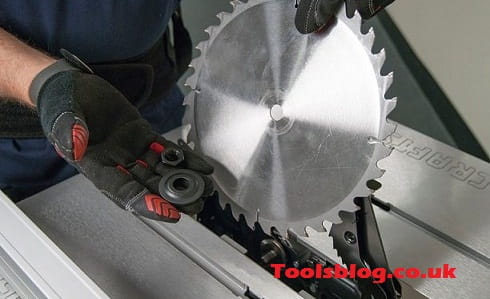A table saw is a powerful and indispensable tool for woodworkers and DIY enthusiasts. It can make straight and clean cuts in different materials, from wood to metal, with precision and ease. However, to ensure the efficiency and safety of your table saw, you need to maintain it properly, including replacing its blade when it's dull, chipped, or worn out. Typically, you'll need a wrench to loosen and tighten the blade nut, but what if you don't have one? Or what if your wrench is misplaced or damaged? Don't worry; changing a table saw blade without a wrench is possible if you follow these steps:

Step 1: Unplug and Secure the Table Saw
Before you start any maintenance or repair task on your table saw, you need to turn it off and unplug it from the power source. This will prevent any accidental start or shock, which can be fatal. Then, you need to secure the blade by locking it in place, so it doesn't rotate or move when you're removing or installing the new one. Check your user manual or consult with an authorized technician for the method that works best for your table saw. Some table saws have a blade lock button or pin that you can push or insert to keep the blade stationary, while others require you to use a wooden block or a clamp to hold the blade from turning.
Step 2: Remove the Blade Nut
Once you've secured the blade, you can try to remove the nut that holds it in place. If you don't have a wrench, you need to find an alternative tool or method that can apply enough force and leverage to loosen the nut. Some of the options you can consider include:
- Pliers: You can use a pair of locking or adjustable pliers to grip the nut and turn it counterclockwise. However, be careful not to damage the nut or the blade teeth, and make sure you apply consistent pressure and grip throughout the process. You may also need to use a cloth or a rubber band to prevent the pliers from slipping or scratching the parts.
- Screwdriver: You can insert a flathead or Phillips screwdriver into the slot of the blade nut and use it as a lever to turn the nut counterclockwise. However, this method may not be as effective as the wrench since the screwdriver may slip or twist under the pressure, and you may not have enough leverage to loosen the nut completely. You may also damage the slot or the screwdriver tip in the process.
- Hammer and Chisel: You can tap the blade nut lightly with a hammer and a chisel to make it slightly loose, and then use pliers or a screwdriver to unscrew it. However, this method is risky since you may damage the threads or the arbor of the table saw, or injure yourself if the chisel slips or breaks. Moreover, it's not a precise or reliable way to remove the nut, especially if it's tight or rusted.
Step 3: Replace the Blade and Nut
Once you've removed the old blade and nut, you can proceed to install the new blade and nut. Make sure you align the blade with the arbor shaft and insert it all the way until it rests on the shoulder. Then, you can tighten the nut by turning it clockwise, using the same tool or method as before. Again, be careful not to overtighten or undertighten the nut, as it can affect the performance and safety of your table saw. Check your user manual or consult with an expert to know the recommended torque or tension for the nut.
Step 4: Test and Adjust the Blade
After you've installed the new blade and nut, you need to test it to see if it runs smoothly and straight. Turn on the table saw and let it spin for a few seconds, checking for any vibration, noise, or wobbling. If you notice any unusual behavior, turn off the saw and check the blade and nut again, making sure they are tight and secure. You may also need to adjust the blade angle or height to suit your cutting needs, using the knobs or levers on the saw body. Take your time and be cautious when making any adjustments, and always wear protective gear like goggles, gloves, and earplugs.
In conclusion, changing a table saw blade without a wrench is possible, but it requires some creativity, patience, and caution. You need to find an alternative tool or method to remove and install the blade nut, and make sure you follow the safety guidelines and user manual instructions. Don't use brute force or makeshift tools that can damage the table saw or cause injury to yourself, and always test and adjust the blade to ensure its optimal performance and precision. Happy sawing!